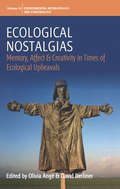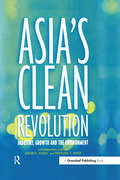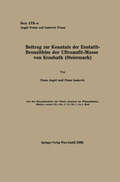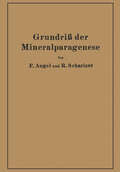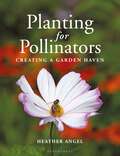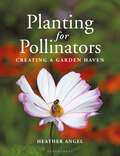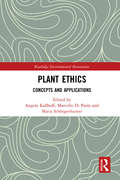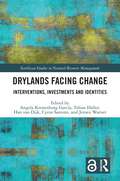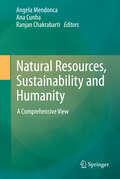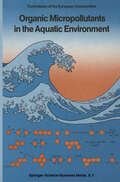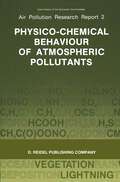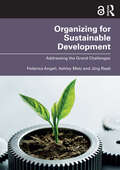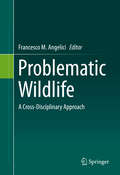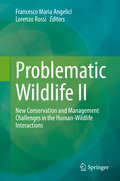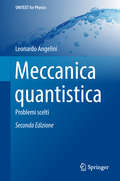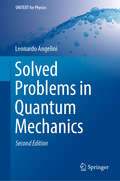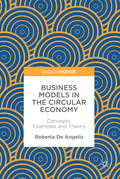- Table View
- List View
Nonlinear Mathematical Physics and Natural Hazards: Selected Papers from the International School and Workshop held in Sofia, Bulgaria, 28 November – 02 December, 2013 (Springer Proceedings in Physics #163)
by Boyka Aneva Mihaela Kouteva-GuentchevaThis book is devoted to current advances in the field of nonlinear mathematical physics and modeling of critical phenomena that can lead to catastrophic events. Pursuing a multidisciplinary approach, it gathers the work of scientists who are developing mathematical and computational methods for the study and analysis of nonlinear phenomena and who are working actively to apply these tools and create conditions to mitigate and reduce the negative consequences of natural and socio-economic disaster risk.This book summarizes the contributions of the International School and Workshop on Nonlinear Mathematical Physics and Natural Hazards, organized within the framework of the South East Europe Network in Mathematical and Theoretical Physics (SEENET MTP) and supported by UNESCO. It was held at the Bulgarian Academy of Sciences from November 28 to December 2, 2013.The contributions are divided into two major parts in keeping with the scientific program of the meeting. Among the topics covered in Part I (Nonlinear Mathematical Physics towards Critical Phenomena) are predictions and correlations in self organized criticality, space-time structure of extreme current and activity events in exclusion processes, quantum spin chains and integrability of many-body systems, applications of discriminantly separable polynomials, MKdV-type equations, and chaotic behavior in Yang-Mills theories. Part II (Seismic Hazard and Risk) is devoted to probabilistic seismic hazard assessment, seismic risk mapping, seismic monitoring, networking and data processing in Europe, mainly in South-East Europe.The book aims to promote collaboration at the regional and European level to better understand and model phenomena that can cause natural and socio-economic disasters, and to contribute to the joint efforts to mitigate the negative consequence of natural disasters. This collection of papers reflects contemporary efforts on capacity building through developing skills, exchanging knowledge and practicing mathematical methods for modeling nonlinear phenomena, disaster risk preparedness and natural hazards mitigation.The target audience includes students and researchers in mathematical and theoretical physics, earth physics, applied physics, geophysics, seismology and earthquake danger and risk mitigation.
Some Aspects of the Formation of the Solar System (SpringerBriefs in Earth Sciences)
by Vsevolod N. Anfilogov Yurij V. KhachayThis book is devoted to the problems that occur when attempting to understand and construct a concise representation of the original conditions, composition and dynamics of the evolution of the Earth-Moon system in the form in which it is seen today. This volume will perhaps contribute to a better understanding of what is necessary to research the dynamics of the Solar system.
Optimal Reliability-Based Design of Structures Against Several Natural Hazards
by Alfredo H-S Ang David de Escobedo Wenliang FanInterest in the topic of structural reliability and optimal design has been rapidly growing in recent years. Besides, the field of numerical methods and artificial intelligence is experiencing a surge of new methods and the refinement of existing ones to expand opportunities to apply robust formulations to complex engineering problems. Today, more than ever, the field is receiving fresh ideas on how to face the challenges of finding a balance between cost and benefits that may lead towards the optimal design of systems. Recently, the probability density evolution method (PDEM) was proposed by Prof. Jie Li as an alternative way to obtain the stochastic and dynamic solution of the safety level of engineering systems under any kind of hazard. This work deals with the application of this powerful method to derive optimal design recommendations for large engineering systems under natural hazards. The three case studies illustrate to engineers and academic specialists how to strike a cost-effective balance in designing such systems.
Optimal Reliability-Based Design of Structures Against Several Natural Hazards
by Alfredo H-S Ang David de Escobedo Wenliang FanInterest in the topic of structural reliability and optimal design has been rapidly growing in recent years. Besides, the field of numerical methods and artificial intelligence is experiencing a surge of new methods and the refinement of existing ones to expand opportunities to apply robust formulations to complex engineering problems. Today, more than ever, the field is receiving fresh ideas on how to face the challenges of finding a balance between cost and benefits that may lead towards the optimal design of systems. Recently, the probability density evolution method (PDEM) was proposed by Prof. Jie Li as an alternative way to obtain the stochastic and dynamic solution of the safety level of engineering systems under any kind of hazard. This work deals with the application of this powerful method to derive optimal design recommendations for large engineering systems under natural hazards. The three case studies illustrate to engineers and academic specialists how to strike a cost-effective balance in designing such systems.
Ecological Nostalgias: Memory, Affect and Creativity in Times of Ecological Upheavals (Environmental Anthropology and Ethnobiology #26)
by Olivia Angé David BerlinerIntroducing the study of econostalgias through a variety of rich ethnographic cases, this volume argues that a strictly human centered approach does not account for contemporary longings triggered by ecosystem upheavals. In this time of climate change, this book explores how nostalgia for fading ecologies unfolds into the interstitial spaces between the biological, the political and the social, regret and hope, the past, the present and the future.
Higher Education and SDG17: Partnerships for the Goals (Higher Education and the Sustainable Development Goals)
by Ángel Cabrera and Drew CutrightCo-edited by the president of Georgia Tech, one of America’s leading research universities, Higher Education and SDG17: Partnerships for the Goals demonstrates how higher education institutions are uniquely positioned to act as catalysts, conveners, and supporters of key partnerships to help advance the United Nations’ Sustainable Development Goals. Featuring authors from higher education institutions, educational networks, and governing bodies around the globe, chapters provide case studies, inspiration, reflections, and critical perspectives from a variety of geographies, disciplines, and partners on how HEI partnerships can rapidly accelerate progress on the goals. Responding to an urgent need for a mind shift towards collaboration and collective action, this is a uniquely global roadmap for higher education leaders, students, faculty, staff, and other partners, to take on the immense challenge of achieving the Sustainable Development Goals. Higher Education and the Sustainable Development Goals is a series of 17 books that address each of the SDGs in turn specifically through the lens of higher education. Adopting a solutions-based approach, each book focuses on how higher education is advancing delivery of sustainable development and the United Nations global goals. The series is edited by Wendy Purcell, Professor with Rutgers University and Academic Research Scholar with Harvard University; Emeritus Professor and University President Emerita.
Asia's Clean Revolution: Industry, Growth and the Environment
by David Angel Michal RockThe world's environmental future will be determined in significant part by what happens in the rapidly industrialising and urban economies of Asia. The sheer scale of urban population and industrial growth in Asia - from Indonesia to China - and the energy and materials intensive character of the development process constitutes a dark shadow over the region's, and indeed the world's, environment. And yet this challenge is also an opportunity. Precisely because so much of the urban-industrial investment within developing Asia has yet to take place, the opportunity exists to shape a different development future - one that is far less energy, materials and waste intensive.Asia's Clean Revolution examines the prospects for and pathways to such a new trajectory. The book lays out a path-breaking vision of how developing economies might go beyond environmental regulation and put in place an array of policies and institutions that could integrate environmental, industrial and technological goals. These findings provide important input for negotiators considering climate change on a global scale.The book approaches the challenge of growth and environment in Asia in a novel way, by identifying six major transformational dynamics under way in the world today, and assessing whether these can be harnessed to the goal of improved environmental performance of industry.With a set of specially commissioned chapters from the leading authorities in North America and Asia, this ground-breaking book is the first to present concrete policy solutions to the looming crisis driven by large-scale urban-industrial growth in developing Asia.
Asia's Clean Revolution: Industry, Growth and the Environment
by David Angel Michal RockThe world's environmental future will be determined in significant part by what happens in the rapidly industrialising and urban economies of Asia. The sheer scale of urban population and industrial growth in Asia - from Indonesia to China - and the energy and materials intensive character of the development process constitutes a dark shadow over the region's, and indeed the world's, environment. And yet this challenge is also an opportunity. Precisely because so much of the urban-industrial investment within developing Asia has yet to take place, the opportunity exists to shape a different development future - one that is far less energy, materials and waste intensive.Asia's Clean Revolution examines the prospects for and pathways to such a new trajectory. The book lays out a path-breaking vision of how developing economies might go beyond environmental regulation and put in place an array of policies and institutions that could integrate environmental, industrial and technological goals. These findings provide important input for negotiators considering climate change on a global scale.The book approaches the challenge of growth and environment in Asia in a novel way, by identifying six major transformational dynamics under way in the world today, and assessing whether these can be harnessed to the goal of improved environmental performance of industry.With a set of specially commissioned chapters from the leading authorities in North America and Asia, this ground-breaking book is the first to present concrete policy solutions to the looming crisis driven by large-scale urban-industrial growth in developing Asia.
Beitrag zur Kenntnis der Enstatit-Bronzitfelse der Ultramafit-Masse von Kraubath (Sitzungsberichte der Österreichischen Akademie der Wissenschaften)
by Franz Angel Franz LaskovicGrundriß der Mineralparagenese
by Franz Angel Rudolf ScharizerDieser Buchtitel ist Teil des Digitalisierungsprojekts Springer Book Archives mit Publikationen, die seit den Anfängen des Verlags von 1842 erschienen sind. Der Verlag stellt mit diesem Archiv Quellen für die historische wie auch die disziplingeschichtliche Forschung zur Verfügung, die jeweils im historischen Kontext betrachtet werden müssen. Dieser Titel erschien in der Zeit vor 1945 und wird daher in seiner zeittypischen politisch-ideologischen Ausrichtung vom Verlag nicht beworben.
Planting for Pollinators: Creating a Garden Haven
by Ms Heather AngelPlanting for Pollinators is an easy-to-use gardening guide to help you encourage different types of insect pollinators into your garden.Insect pollinators not only bring joy to our gardens, they also provide an essential service for our planet. Without bees, flies, hoverflies, butterflies, moths and beetles, some of our favourite foods, flowers and plants would cease to exist. Whether you have a large garden, an urban balcony or just a window box, planting to encourage pollinators is a fantastic and surprisingly easy first step in creating a wildlife-friendly space. Planting for Pollinators features a wide range of plants, with guidance on the best ways to nurture lawns and verges, pollinator predation and tips on watching and photographing wildlife. Beautifully illustrated throughout with images from award-winning wildlife photographer Heather Angel, this essential guide will show you how plants communicate with insects, and why it's so important to protect our pollinators. Organised by season and featuring more than 100 plant species – including bulbs, annuals, perennials, shrubs and climbers – this practical guide will help you to discover the short- and long-term benefits of having a variety of pollinators visit your garden.
Planting for Pollinators: Creating a Garden Haven
by Ms Heather AngelPlanting for Pollinators is an easy-to-use gardening guide to help you encourage different types of insect pollinators into your garden.Insect pollinators not only bring joy to our gardens, they also provide an essential service for our planet. Without bees, flies, hoverflies, butterflies, moths and beetles, some of our favourite foods, flowers and plants would cease to exist. Whether you have a large garden, an urban balcony or just a window box, planting to encourage pollinators is a fantastic and surprisingly easy first step in creating a wildlife-friendly space. Planting for Pollinators features a wide range of plants, with guidance on the best ways to nurture lawns and verges, pollinator predation and tips on watching and photographing wildlife. Beautifully illustrated throughout with images from award-winning wildlife photographer Heather Angel, this essential guide will show you how plants communicate with insects, and why it's so important to protect our pollinators. Organised by season and featuring more than 100 plant species – including bulbs, annuals, perennials, shrubs and climbers – this practical guide will help you to discover the short- and long-term benefits of having a variety of pollinators visit your garden.
Plant Ethics: Concepts and Applications (Routledge Environmental Humanities)
by Angela Kallhoff, Marcello Di Paola and Maria SchörgenhumerLarge parts of our world are filled with plants, and human life depends on, interacts with, affects and is affected by plant life in various ways. Yet plants have not received nearly as much attention from philosophers and ethicists as they deserve. In environmental philosophy, plants are often swiftly subsumed under the categories of "all living things" and rarely considered thematically. There is a need for developing a more sophisticated theoretical understanding of plants and their practical role in human experience. Plant Ethics: Concepts and Applications aims at opening a philosophical discussion that may begin to fill that gap. The book investigates issues in plants ontology, ethics and the role of plants and their cultivation in various fields of application. It explores and develops important concepts to shape and frame plants-related philosophical questions accurately, including new ideas of how to address moral questions when confronted with plants in concrete scenarios. This edited volume brings together for the first time, and in an interdisciplinary spirit, contemporary approaches to plant ethics by international scholars of established reputation. It will be of great interest to students and scholars of Philosophy and Ethics.
Drylands Facing Change: Interventions, Investments and Identities (Earthscan Studies in Natural Resource Management)
by Angela Kronenburg García, Tobias Haller, Han van Dijk, Cyrus Samimi, Jeroen WarnerThis edited volume examines the changes that arise from the entanglement of global interests and narratives with the local struggles that have always existed in the drylands of Africa, the Middle East, and Central Asia and Inner Asia. Changes in drylands are happening in an overwhelming manner. Climate change, growing political instability, and increasing enclosures of large expanses of often common land are some of the changes with far-reaching consequences for those who make their living in the drylands. At the same time, powerful narratives about the drylands as ‘wastelands’ and their ‘backward’ inhabitants continue to hold sway, legitimizing interventions for development, security and conservation, informing re-emerging frontiers of investment (for agriculture, extraction, infrastructure), and shaping new dryland identities. The chapters in this volume discuss the politics of change triggered by forces as diverse as the global land and resource rush, the expansion of new Information and Communication Technologies, urbanization, the COVID-19 pandemic, and the spread of violent extremism. While recognizing that changes are co-produced by differently positioned actors from within and outside the drylands, this volume presents the dryland’s point of view. It therefore takes the views, experiences, and agencies of dryland dwellers as the point of departure to not only understand the changes that are transforming their lives, livelihoods, and future aspirations, but also to highlight the unexpected spaces of contestation and innovation that have hitherto remained understudied. This edited volume will be of much interest to students, researchers and scholars of natural resource management, land and resource grabbing, political ecology, sustainable development and drylands in general.
Natural Resources, Sustainability and Humanity: A Comprehensive View
by Angela Mendonca, Ana Cunha and Ranjan ChakrabartiShortly, this book is the written up-graded version of the topics discussed during the Small Meeting of the 2nd International School Congress: Natural Resources, Sustainability and Humanity, held in Braga, Portugal, 5-8 May 2010 with the diverse participation of scientists, educators and governmental representatives. The Earth hosts an immense ecosystem, colonized by millions of species for billions of years but only for a few tens of thousands of years by humans. Environmental history tells though that it was humankind that shaped the environment as no other species. History, geography, religion and politics among other reasons have differentiated populations with respect to access to safe food and water, education, health, and to space and natural resource utilization. The globalization era of trade, information and communication is shortening distances and increasing overall wealth, but, as is pointed out in this book, it is also contributing to the propagation of diseases, and to the modification or even destruction of native ecosystems by exotic invasive species.Man is the only species that has the perception of its history, evolution, of the consequences of its decisions, and that there is a future ahead. It is also the only species that has the potential to change it. This awareness can be a source of anxiety and contradictory behaviours, but it is also the key to changing attitudes towards the construction of a common sustainable home, by committed education, interdisciplinary approaches, mobilization and empowerment of people and political consonant actions.
Organic Micropollutants in the Aquatic Environment: Proceedings of the Sixth European Symposium, Held in Lisbon, Portugal, May 22–24, 1990
by G. Angeletti A. BjørsethMore than 10 years after the "First European Symposium on Organic Micropollutants in the Aquatic Environment", the "Sixth Symposium" was held in Lisbon (Portugal) from 22 to 24 May 1990. The Symposium was organised within the framework of the Concerted Action COST 641 * which is included in the Fourth R&D Programme on the Environment of the Commission of the European Communities expiring at the end of 1990. After restructuring the Concerted Action in 1984, particular attention has been devoted to fate and transformation of organic micropollutants in the aquatic environment. Therefore, a major aim of the Symposium was to review current studies and progress in these areas, besides more general aspects related to analytical methodologies and behaviour of pollutants during water treatment processes. This volume contains the plenary papers presented in the following sessions at the Symposium: - Multidisciplinary studies - Partitioning of organic micropollutants in the aquatic environment - Novel analytical techniques in environmental chemistry - Monitoring micropollutant - Degradation of organic micropollutants during field conditions - Reclamation of polluted ground water - Chemical and photochemical oxidation - Future of environmental chemistry. In addition, extended versions of posters are included, covering the four topics which are dealt within the four Working Parties forming the structure of the Concerted Action: 1. Analytical methodologies 2. Transport and distribution 3. Transformation reactions 4. Water treatment. We believe that the Proceedings give a good overview of current activities in these fields of research in Europe.
Physico-Chemical Behaviour of Atmospheric Pollutants: Proceedings of the Fourth European Symposium held in Stresa, Italy, 23–25 September 1986 (Tertiary Level Biology Ser.)
by G. Angeletti G. RestelliFourth European Symposium held in Stresa, Italy, September 23-25, 1986
Organizing for Sustainable Development: Addressing the Grand Challenges
by Federica Angeli Ashley Metz Jörg RaabThe Sustainable Development Goals (SDGs) recognize the increasingly complex, interdependent nature of societal and environmental issues for governments and business. Tackling such "grand challenges" requires the concerted action of a multitude of organizations and multiple stakeholders at different levels in the public, private, and non-profit sector.Organizing for Sustainable Development provides an integrated and comparative overview of the successes and failures of organizational efforts to tackle global societal issues and achieve sustainable development. Summarizing years of study by an interdisciplinary board of authors and contributors, this book provides readers with an in-depth understanding of how existing businesses and new hybrid organizations can achieve sustainable development to bring about an improved society, marking a key contribution to the literature in this field.Combining theoretical views with empirical approaches, the chapters in this book are highly relevant to graduate and undergraduate (multidisciplinary) programs in sustainable development, organization studies, development economics, development studies, international management, and social entrepreneurship.The Open Access version of this book, available at www.taylorfrancis.com, has been made available under a Creative Commons Attribution-NonCommercial (CC-BY) 4.0 license.
Organizing for Sustainable Development: Addressing the Grand Challenges
by Federica Angeli Ashley Metz Jörg RaabThe Sustainable Development Goals (SDGs) recognize the increasingly complex, interdependent nature of societal and environmental issues for governments and business. Tackling such "grand challenges" requires the concerted action of a multitude of organizations and multiple stakeholders at different levels in the public, private, and non-profit sector.Organizing for Sustainable Development provides an integrated and comparative overview of the successes and failures of organizational efforts to tackle global societal issues and achieve sustainable development. Summarizing years of study by an interdisciplinary board of authors and contributors, this book provides readers with an in-depth understanding of how existing businesses and new hybrid organizations can achieve sustainable development to bring about an improved society, marking a key contribution to the literature in this field.Combining theoretical views with empirical approaches, the chapters in this book are highly relevant to graduate and undergraduate (multidisciplinary) programs in sustainable development, organization studies, development economics, development studies, international management, and social entrepreneurship.The Open Access version of this book, available at www.taylorfrancis.com, has been made available under a Creative Commons Attribution-NonCommercial (CC-BY) 4.0 license.
Problematic Wildlife: A Cross-Disciplinary Approach
by Francesco M. AngeliciThis book provides insight into the instances in which wildlife species can create problems. Some species trigger problems for human activities, but many others need humans to save them and to continue to exist. The text addresses issues faced by economists and politicians dealing with laws involving actions undertaken to resolve the problems of the interaction between humans and wildlife. Here, the words ‘problematic species’ are used in their broadest sense, as may be appreciated in the short introductions to the various sections. At times, the authors discuss special cases while always extending the discussion into a more general and broad vision. At others, they present real cutting-edge analysis of ecological topics and issues. The book will be of interest to biologists, ecologists and wildlife managers involved in research on wildlife, parks, and environmental management, as well as to government departments and agencies, NGOs and conservation wildlife organizations. Even those in contact with nature, such as hunters, herders, and farmers, will be able to find a great deal of important information. Specific case studies are selected from among the most significant and prevalent cases throughout the world. A total of 26 papers have been selected for this book, written by zoologists, biologists and ecologists. Many have an interdisciplinary approach, with contributions by economists, criminologists, technical specialists, and engineers.
Problematic Wildlife II: New Conservation and Management Challenges in the Human-Wildlife Interactions
by Francesco Maria Angelici Lorenzo RossiIn a world where habitats are constantly changing and the impact of anthropization on the environment is increasingly intense, interactions between human and wildlife are becoming more and more complex. Some species pose problems for human activities while many others need to be helped in order to continue to exist. This book follows the first volume called 'Problematic Wildlife', edited by F.M. Angelici and published by Springer in 2016, which has had considerable success with readers and critics. The volume includes 21 chapters divided into 7 parts devoted specific topics which are approached in a multidisciplinary way. There are both review chapters and specific cases, always bearing in mind the interest for an international audience. The book is useful both for scientists, wildlife specialists, conservationists, zoologists, ecologists, university students, nature managers, and for those who live in contact with wildlife and its problems, such as farmers, shepherds, hunters, urban planners, and staff of parks and nature reserves. Its ultimate goal is to offer scientific and pragmatic approaches to manage each categories of problematic species.
Meccanica Quantistica: Problemi Scelti (UNITEXT for Physics)
by Leonardo AngeliniIn questa seconda edizione la scelta dei problemi presentati è stata ampliata con alcuni nuovi esercizi come i potenziali quadrati. La raccolta si arricchisce anche dell'aggiunta di due capitoli su metodi di approssimazione diversi dalla teoria perturbativa, approssimazione WKB e Variazionale. Questo libro è dedicato agli studenti che preparano l'esame scritto di un corso di Meccanica Quantistica e presenta problemi che possono essere risolti nei tempi normalmente dedicati agli esami scritti. Di riflesso questa raccolta può risultare molto utile anche ai docenti che devono proporre problemi ai loro studenti sia a lezione che per gli esami. Si assume che i contenuti del corso siano sostanzialmente identici a quelli di un tradizionale corso di Istituzioni di Fisica Teorica dei vecchi ordinamenti del corso di laurea in Fisica. Nei nuovi ordinamenti gli stessi argomenti sono stati, in generale, ripartiti su più corsi.Oltre a sondare la comprensione della materia e l'abilità di applicarla concretamente da parte dello studente, i problemi sono risolvibili in un tempo limitato utilizzando gli strumenti matematici che vengono normalmente forniti nei corsi per la laurea in Fisica. Le soluzioni sono fornite in modo dettagliato, eliminando i passaggi più semplici, per una maggiore fruibilità da parte degli studenti.
Solved Problems in Quantum Mechanics (UNITEXT for Physics)
by Leonardo AngeliniThis book presents a large collection of problems in Quantum Mechanics that are solvable within a limited time and using simple mathematics. The problems test both the student’s understanding of each topic and their ability to apply this understanding concretely. Solutions to the problems are provided in detail, eliminating only the simplest steps. No problem has been included that requires knowledge of mathematical methods not covered in standard courses, such as Fuchsian differential equations. The book is in particular designed to assist all students who are preparing for written examinations in Quantum Mechanics, but will also be very useful for teachers who have to pose problems to their students in lessons and examinations.
Business Models in the Circular Economy: Concepts, Examples And Theory
by Roberta De AngelisThis book focuses on the role of corporations in the transition towards an economy that works more in line with ecological limits. It is centred on business model innovation in the context of the circular economy, which is gaining consensus across business, policy and academic circles by proposing more resource efficient industrial processes. Interest in circular business models is growing within academic and practitioner literature yet the concept is not clearly understood, with potential negative consequences for theory building and practical implementation. Therefore, this book conceptualises circular business models and investigates their theoretical foundations in relation to the rationale for adopting them, drawing on circular economy, business model, strategic management and neo-institutional literature and secondary data.
Business Models in the Circular Economy: Concepts, Examples and Theory
by Roberta De AngelisThis book focuses on the role of corporations in the transition towards an economy that works more in line with ecological limits. It is centred on business model innovation in the context of the circular economy, which is gaining consensus across business, policy and academic circles by proposing more resource efficient industrial processes. Interest in circular business models is growing within academic and practitioner literature yet the concept is not clearly understood, with potential negative consequences for theory building and practical implementation. Therefore, this book conceptualises circular business models and investigates their theoretical foundations in relation to the rationale for adopting them, drawing on circular economy, business model, strategic management and neo-institutional literature and secondary data.



